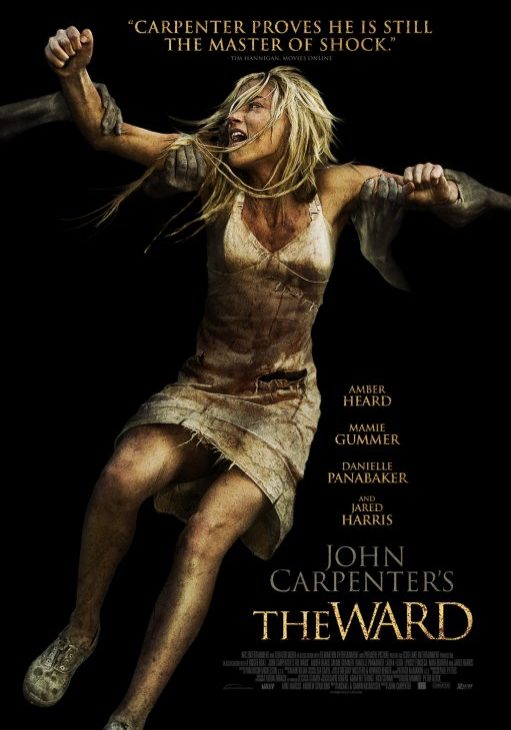Whispers in the Ward: The Forgotten Screams of John Carpenter’s “The Ward”
“In here, everything gets better,” begins the eerie promise of North Bend Psychiatric Hospital, where John Carpenter’s “The Ward” sets its stage for horror. Premiering in 2010, this film marked the celebrated director’s return to the genre after a decade-long hiatus. Through the haunted corridors and flickering lights, “The Ward” presents a tale of a young amnesiac woman, Kristen, played by Amber Heard, who finds herself locked in a psychiatric hospital. With other patients tormented by a menacing ghost, the film flirts with elements of mystery and supernatural horror, keeping the audiences guessing until its final, cruel twist.
Creating a Chilling Atmosphere: The Art of Unsettled Anticipation
“The Ward” excels in atmospheric tension. Carpenter, known for his masterful use of suspense, utilizes the claustrophobic confines of the psychiatric hospital to invoke a palpable sense of dread. Throughout the film, the horror is derived less from outright scares and more from a creeping sense of foreboding, which quietly gnaws at the viewer. The director adeptly builds fear through anticipation rather than relying solely on the manifestation of the horrors themselves.
The Labyrinth of Lights and Shadows
Cinematographically, “The Ward” is a testament to Carpenter’s eye for composition and mood. The lighting veils the hospital in an almost perpetual twilight, which, coupled with muted color palettes, blankets the movie in an aura that is both haunting and desolate. Camera angles are thoughtfully chosen to create a sense of confinement and surveillance, while the scarce use of special effects ensures the ghostly apparitions have a startling and visceral impact when they do appear. One particularly notable technique is the use of reflections and transparency, symbolizing the fractured psyches within the ward.
Soundscapes of the Unseen Terror
Sound design in “The Ward” is a subtle yet crucial component of its horror. The uneasy silence that permeates much of the film is punctuated by an evocative soundtrack and carefully timed sound effects, escalating the tension to near unbearable levels. Moments of silence before sudden jarring noises exemplify how the soundscape effectively contributes to the shocks and scares, each note and whisper meticulously orchestrated to amplify the fear factor.
Haunting Performances: Portraits of Frayed Minds
The ensemble of characters in “The Ward” is a mosaic of troubled histories and cracked realities. While the development of these characters sometimes takes a backseat to the film’s overarching mystery, the performances remain convincing. Amber Heard delivers a performance that stands out, grappling with terror and confusion with commendable conviction. The psychological distress of these characters manifesting in their interactions and the building tension amongst them exemplifies the cast’s ability to shoulder the movie’s atmosphere of horror, even if the script at times limits their ability to fully showcase their range.
Mind Games and Ghostly Revelations: The Mechanics of Fear in “The Ward”
Delving into the mechanics of horror within “The Ward,” it’s clear that psychological elements blend with supernatural phenomena to rattle the audience. Carpenter doesn’t indulge in excessive gore or body horror but instead employs shock tactics and an omnipresent unseen threat to create apprehension. The techniques are traditional—jump scares and dream sequences—and while they are well-crafted, some may argue that they lack the innovative punch expected from a director of Carpenter’s caliber.
The thematic undercurrent of mental health and trauma is woven throughout the narrative. The film uses the horrors of the ward to comment on the dark aspects of psychiatric care and the stigmatization of mental illness in the 1960s, but it does so without deeply engaging in social critique. While the ghost story may serve as a metaphor for the characters’ individual and collective traumas, the exploration of these deeper issues feels somewhat overshadowed by the emphasis on the mystery and suspense elements.
Final Thoughts: A Dimly Lit Corridor in Carpenter’s Gallery of Horror
Does “The Ward” live up to Carpenter’s storied legacy? This is a film that straddles the line between traditional horror tropes and psychological thrills. It’s a competently made, moody piece with moments of genuine fright, but it doesn’t quite reach the pioneering heights of the director’s earlier works. Nonetheless, horror aficionados may find enjoyment in its atmospheric chills and narrative twists, although casual viewers might be left wanting more substance beneath the style.
As a critic, I see “The Ward” as an intriguing but flawed entry into Carpenter’s oeuvre. It’s best suited to those with a penchant for haunted asylum stories and old-school scares. Its strengths lie in atmosphere and performance, but its measured approach to horror may not enrapture everyone, and graphic content is minimal, making it accessible to a broader audience.
When compared to classic and contemporary horror films, “The Ward” doesn’t fully emerge from the shadows of its predecessors. While it’s worth a watch for its atmospheric chills, it primarily will resonate with Carpenter’s fans and those seeking a throwback horror experience without the gore. With this in mind, “The Ward” receives a hesitant recommendation: an echo of horror’s past that resonates with a certain nostalgia but lacks the impact of a modern-day nightmare.




